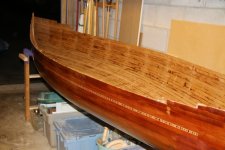Sorry for the delay in posting folks. It has been a busy time for us right now.
OK, enough suspense on who came to visit me...I had Roger Foster from Carlisle Canoe Co come to have a look at my creation. Carlisle Canoe is about a 20 min drive from my house. They build all things wood canoes, and paddles. I called them originally to get a little advice on my not so wide fiberglass dilemma. We talked on the phone for a bit, and he offered to come have a look at my build so far. I have to say, I am very impressed with Roger. What a great guy, and a great resource to be able to glean info from. He is a totally laid back guy with a great approach to these builds. He apparently has done a few hundred canoe builds, so I think he knows what he is doing!
So, he really liked what I have done so far, and told me to go ahead and apply the fiberglass as is. The area that will not be covered by the fiberglass is only a small run right at the widest point, so he said to overlap and feather in a small section after the first coat has set. If that's what he would do then I'm OK with that.
Saturday is the day, so I will be posting before, during, and after shots of the whole procedure. I hope you enjoy.
Go visit Carlisle Canoe. www.carlislecanoe.ca
Momentum
OK, enough suspense on who came to visit me...I had Roger Foster from Carlisle Canoe Co come to have a look at my creation. Carlisle Canoe is about a 20 min drive from my house. They build all things wood canoes, and paddles. I called them originally to get a little advice on my not so wide fiberglass dilemma. We talked on the phone for a bit, and he offered to come have a look at my build so far. I have to say, I am very impressed with Roger. What a great guy, and a great resource to be able to glean info from. He is a totally laid back guy with a great approach to these builds. He apparently has done a few hundred canoe builds, so I think he knows what he is doing!
So, he really liked what I have done so far, and told me to go ahead and apply the fiberglass as is. The area that will not be covered by the fiberglass is only a small run right at the widest point, so he said to overlap and feather in a small section after the first coat has set. If that's what he would do then I'm OK with that.
Saturday is the day, so I will be posting before, during, and after shots of the whole procedure. I hope you enjoy.
Go visit Carlisle Canoe. www.carlislecanoe.ca
Momentum




















